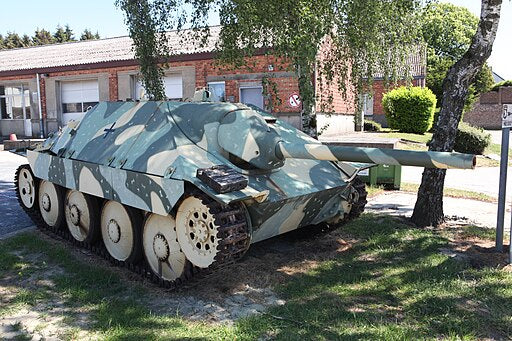When you dive into the rollercoaster that is military history, filled with brilliant moves and epic fails, not many tanks grab your attention quite like the Hetzer, officially known as the 38. Mainly used by the German Wehrmacht and Waffen-SS against the Soviets on the Eastern Front in the later years of World War II, the Hetzer is a perfect example of how sound engineering meets battlefield smarts. Admittedly, when grappling with the nebulous intricacies of war, any mechanical platform is but one component in a vast, interlocking machine. Nevertheless, a tactical overview of the Hetzer’s deployment in the theater reveals an abundance of strategic virtues and drawbacks, which, when considered in the aggregate, offer deep insights into the dynamics of armored warfare in that epic struggle.
Genesis of a Mechanized Hunter
In the years leading up to the Hetzer’s introduction, German military strategists had been beset by many obstacles. The relentless advance of the Red Army and the resultant attrition faced by Panzer divisions led to an urgent demand for a light, cost-effective, but formidable tank destroyer. Developed as a derivative of the Czechoslovakian Panzer 38, the Hetzer was an emblem of pragmatism. Armed with a 75mm Pak 39 L/48 gun, it bore the promise of penetrating the armor of most contemporary Soviet tanks, including the T-34, at standard combat ranges.
Tactile Advantages and Shortcomings
Tactically speaking, the Hetzer was infused with a series of distinct advantages. Its sloping armor was more than a cosmetic flourish; it was a formidable defense mechanism promoting deflection. At a diminutive height of just under 2.1 meters, the Hetzer’s low profile rendered it a challenging target for enemy gunners. At the same time, its superb front armor, approximately 60mm, belied its relatively low weight of 16 tons.
However, this engineering marvel was not without its pitfalls. The lack of a rotating turret confined its lateral field of fire, necessitating a cumbersome repositioning for aiming adjustments. Furthermore, the poor visibility and cramped internal quarters, resulting from the desire to minimize its profile, seriously compromised the crew’s operational capacity, especially during extended combat scenarios.
A Symbiotic Relationship: Hetzer and the Eastern Front
In the merciless expanses of the Eastern Front, the Hetzer found its most challenging yet rewarding theater. Its light weight enabled relatively trouble-free transportation across the inhospitable terrain, from marshes to snow-bound plains. Concurrently, it could be concealed effortlessly amid the rustic landscape, making it an ideal choice for ambushes and defensive operations.
While the Hetzer was agile enough to operate in diverse environmental conditions, it was not impervious to the limitations imposed by the theatre. In a realm where numerical superiority often eclipsed qualitative edge, the Hetzer, despite its remarkable capabilities, could not single-handedly stem the tide of Soviet armor.
Strategic Significance: A Retrospective Examination
From the crucible of Stalingrad to the icy plains of Kursk, the Hetzer’s role cannot be encapsulated as merely contributory or inconsequential. It was an asymmetric tool that added a unique layer to the Wehrmacht’s operational calculus. The Hetzer’s introduction did not revolutionize the Eastern Front, but its presence modified the battle equations to an extent. For commanders of the time, the Hetzer’s adaptability and firepower offered a nuanced blend of tactical possibilities, giving them more latitude to orchestrate sophisticated ploys that incorporated fast strikes, defensive bulwarks, and flanking maneuvers.
Conclusion: An Armor in the Maelstrom
Even though the Hetzer couldn’t single-handedly shift the strategic imbalance afflicting the Axis powers by the latter part of the war, its design and application revealed an enduring lesson: that even in the quagmire of conflict, innovation and adaptability can produce systems that transcend their initial purview. The Hetzer, a relatively unassuming vehicle, fortified the German lines and served as a blueprint for future armored fighting vehicles. And so, nestled within the broader narrative of the Eastern Front, this diminutive hunter assumes a stature that far outstrips its physical dimensions, serving as an unforgettable focal point in the relentless quest to decipher the intricacies of wartime tactics and strategy.
In summation, the Hetzer, its merits and flaws woven into the fabric of its metallic hull, stands as a nuanced chapter in the complex anthology of armored warfare, offering historians and military enthusiasts alike a granular understanding of how tactics and technology intersected during one of the most devastating conflicts in human history.
For more insights into the Jagdpanzer 38 and other important military aircraft, visit Aces In Action. Here, you’ll find an amazing piece of artwork by Craig Tinder titled “The Turn to Rochefort” that illustrates the peak of the German Offensive during the Battle of the Bulge when Panzer Lehr made the fateful turn to Rochefort, Belgium with their remaining Jagdpanzer 38 tank destroyers – informally known as the “Hetzer”. The limited edition canvas print even includes a piece of rear toolbox lid that contains heavy pitting and rust from decades in the Ardennes soil.
The Turn to Rochefort – Jagdpanzer 38 Hetzer Tank Military Art by Artist Craig Tinder
23 December 1944, with the German offensive reaching its peak during the Battle of the Bulge, Jagdpanzer 38 (Sd.Kfz. 138/2) tank destroyers of Germany’s elite Panzer Lehr Division (130th Panzer Division) attacked the town of Rochefort, Belgium. A costly battle for the Germans, Rochefort finally fell by nightfall as the Americans withdrew from the area. With continued fighting over the next few days, Panzer Lehr countered significant resistance and no longer had the strength to deliver effective assaults and was therefore relegated to defend Remagne near Bastogne. Over the following weeks, the division was forced to retreat in the face of continued resistance and supply shortages.






Share:
Heinkel He 111 in the Spanish Civil War: A Combat Debut That Sculpted Aeronautical Warfare
Introduction to the Ilyushin IL-2: The “Flying Tank” of WWII